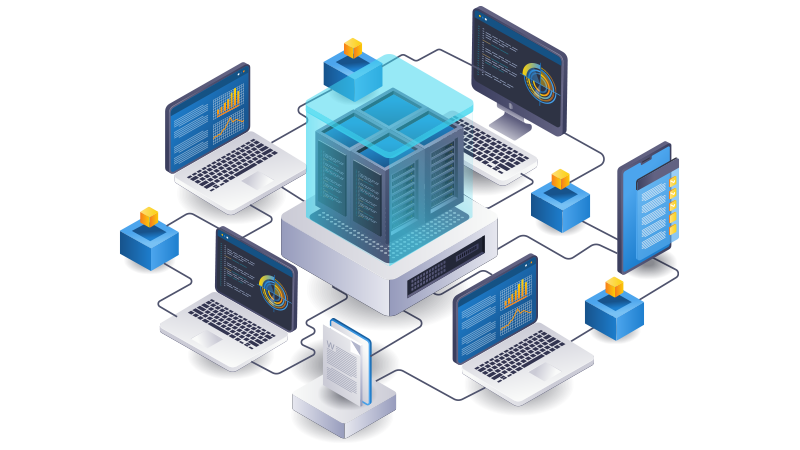- Home
- Solutions and Services
- Modern Infrastructure
- Streamlining the Edge: Infrastructure Management at Scale
Achieving Operational Efficiency through an AIOps Approach to Infrastructure Management
Streamlining the Edge: Infrastructure Management at Scale
Set your team up for success in highly distributed edge environments. This article will uncover strategies for accelerating the deployment of distributed edge infrastructures at scale, including how to enable observability into server health and configuration and to automate device discovery, inventory, tracking, monitoring, and updates.Achieving Operational Efficiency through an AIOps Approach to Infrastructure Management
Streamlining the Edge: Infrastructure Management at Scale
Set your team up for success in highly distributed edge environments. This article will uncover strategies for accelerating the deployment of distributed edge infrastructures at scale, including how to enable observability into server health and configuration and to automate device discovery, inventory, tracking, monitoring, and updates.DevOps and IT Operations in Edge Management
Edge systems management brings the principles and best practices of DevOps into IT operations. By seamlessly integrating and automating software deployment and IT management tasks, DevOps provides a unified framework for application owners and IT operations teams. When applied to edge environments, this framework becomes even more crucial.
DevOps and IT Operations in Edge Management
Edge systems management brings the principles and best practices of DevOps into IT operations. By seamlessly integrating and automating software deployment and IT management tasks, DevOps provides a unified framework for application owners and IT operations teams. When applied to edge environments, this framework becomes even more crucial.

Change Happens. EXPERTISE WINS.™
Power up your team with the latest modern infrastructure solutions to drive greater productivity, collaboration, and security.Talk to an Expert
DevEdgeOps: A Unified Approach
For example, edge deployments may vary widely in scale and location. Some environments require managing hundreds of devices in remote locations with intermittent connectivity, while others involve tightly controlled urban installations. DevEdgeOps provides the tools and practices to manage this complexity effectively.

Key Features for Edge Infrastructure Management
-
1. Multi-modal Deployment
Managing devices, applications, clusters, containers, and virtual servers is foundational to efficient edge system deployment. Edge management tools should allow seamless integration between applications and IT operations teams, fostering a culture of de-siloing. This enables consistent deployment and lifecycle management across diverse systems, ensuring smooth operations even in complex environments. -
2. Platform Flexibility
Edge compute systems come in many forms and rely on various platforms and reference architectures. Effective edge management systems must support integrations and plugins that address the intricacies of each unique platform. Look for flexibility that extends to managing multiple vendors and products within a single solution, enabling organizations to embrace vendor specificity without falling into vendor lock-in. -
3. Zero-touch Deployment
Zero-touch deployment is critical for edge environments. Devices should be automatically detected, identified, validated, and provisioned using automated playbooks. These playbooks should build a unified stack from bare-metal systems to user-accessible applications. This approach minimizes manual intervention and accelerates deployment, even for large-scale edge environments. -
4. Connectivity Optimization
Many edge devices operate in remote or intermittently connected environments. Effective edge management systems must account for these dynamic connectivity profiles, ensuring reliable management and data transmission even when connectivity is limited. This includes features like offline provisioning and synchronization once connectivity is restored. -
5. Location Awareness?
Edge environments often involve highly distributed deployments with varying data repositories and formats. Management systems must incorporate physical location awareness to optimize provisioning and updates. For example, edge systems in urban centers may have different connectivity and resource requirements compared to those in remote areas.

-
6. Uniformity and Consistency?
Consistency is critical for security and stability. Edge management platforms should support template-based deployment and configuration management while allowing for the diversity inherent in edge environments. This balance ensures that all deployments adhere to organizational standards without sacrificing the flexibility required for unique edge scenarios. -
7. Intrinsic Security
Security must be built into every aspect of edge management. From validating edge devices to securing operator access, repositories, and connectivity, comprehensive security measures are non-negotiable. Edge systems must validate and trust the devices they manage, ensuring that only authorized components are deployed and operated.
Accelerating Edge Deployment at Scale
- Automated Provisioning: Automating the setup of bare-metal devices, operating systems, and virtualized environments reduces time-to-value and minimizes errors.
- Lifecycle Management: Comprehensive tools that provide continuous monitoring, updates, and scaling capabilities ensure edge environments remain operational and optimized.
- Observability and Monitoring: Advanced edge servers can track server health, configuration, and performance metrics, enabling proactive maintenance and rapid issue resolution.
Organizations deploying distributed edge systems should also consider leveraging AI and machine learning for predictive analytics. For example, monitoring tools can analyze system performance data to predict hardware failures, allowing IT teams to address issues before they impact operations.

DevEdgeOps in Action
- Streamlines deployment using zero-touch provisioning, enabling new stores to come online in hours rather than days.
- Ensures consistent performance across locations with template-based configuration management.
- Implements robust security protocols to protect customer data and prevent unauthorized access to edge devices.
- Monitors and updates edge devices remotely, reducing downtime and maintenance costs.

Conclusion
Connection Can Help
Connection is your partner for modern infrastructure and edge management solutions and services. From hardware and software to consulting and customized solutions, we’re leading the way in infrastructure modernization.
To learn more, explore our Modern Infrastructure and Cybersecurity Solutions and Services—or reach out to an expert today!
Contact UsConnection Community
A Pulse on the State of Cybersecurity in...
The healthcare industry is currently facing an unprecedented wave of cyber threats. In 2024 alone, healthcare organizations experienced an average... Read More
Top Trends in Manufacturing Factory...
The manufacturing industry is undergoing a practical transformation—driven by the necessity for improved efficiency, enhanced security, and a future-ready infrastructure.... Read More
OT Cybersecurity Can No Longer Be Ignored
The threat of cyberattacks is escalating at a terrifying rate. A staggering 84% of businesses surveyed experienced at least one... Read More
TechSperience Episode 131: Securing Industry 4.0
The manufacturing sector is racing towards a digital future, but this innovation brings an explosion of cyber threats. This episode... Read More
Cyber Threats in Education and What to Do...
The top target for ransomware attacks isn’t the healthcare industry or the critical infrastructure as many may assume. It is... Read More




